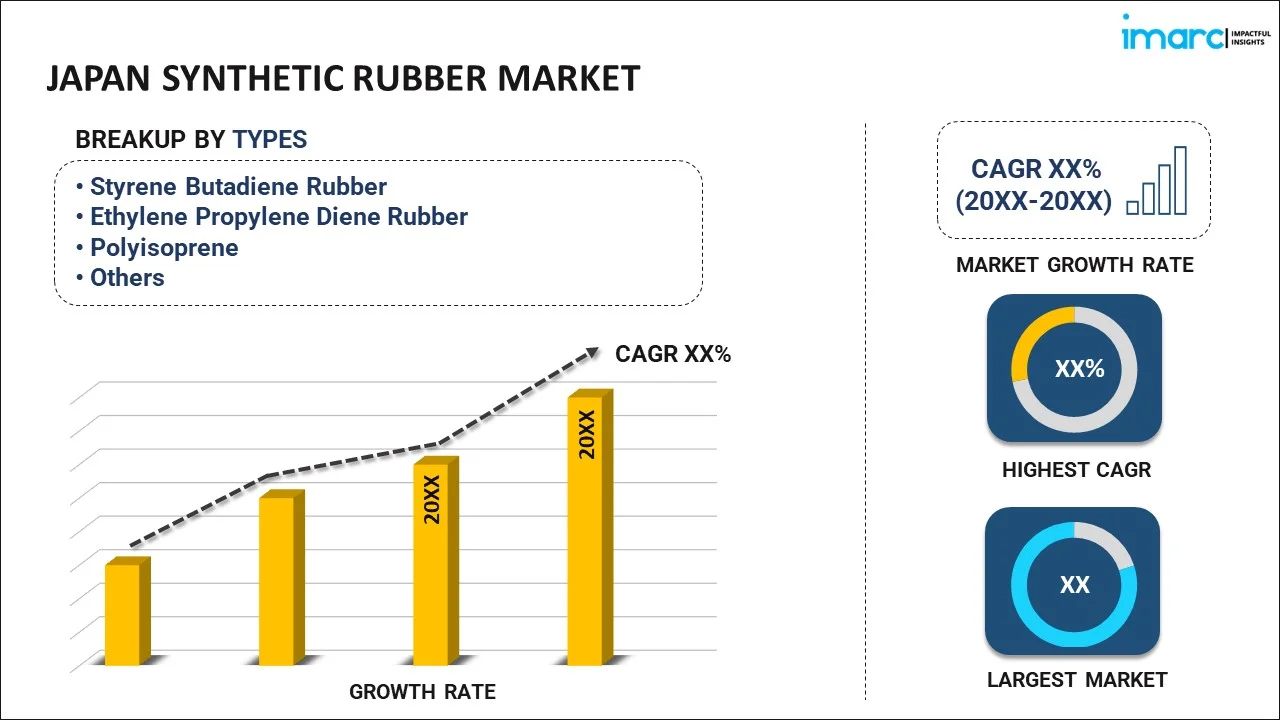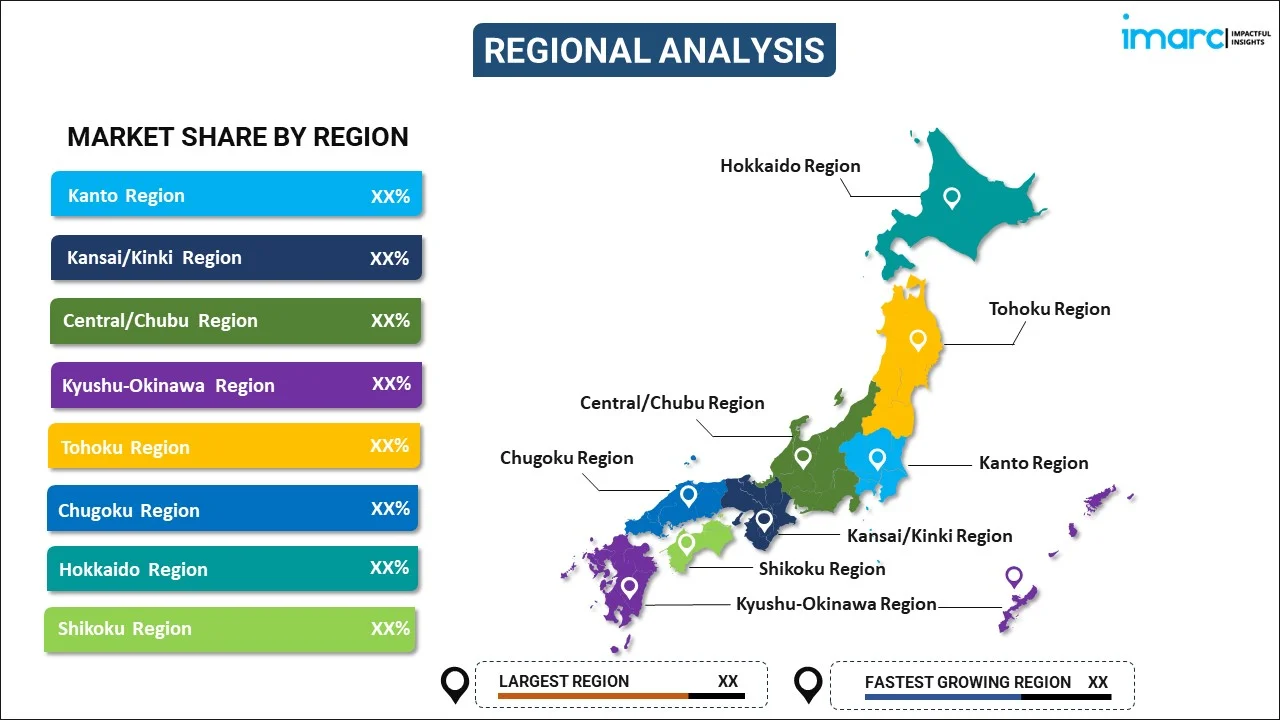
Japan Synthetic Rubber Market Report by Type (Styrene Butadiene Rubber, Ethylene Propylene Diene Rubber, Polyisoprene, Polybutadiene Rubber, Isobutylene Isoprene Rubber, and Others), Form (Liquid Synthetic Rubber, Solid Synthetic Rubber), Application (Tire and Tire Component, Non-Tire Automobile Application, Footwear, Industrial Goods, and Others), and Region 2025-2033
Market Overview:
Japan synthetic rubber market size reached 1.2 Million Tons in 2024. Looking forward, IMARC Group expects the market to reach 1.7 Million Tons by 2033, exhibiting a growth rate (CAGR) of 3.3% during 2025-2033. Extensive investments in R&D activities by leading manufacturers to develop eco-friendly alternatives, along with the advancements in the production of tires, are primarily augmenting the market growth.
|
Report Attribute
|
Key Statistics
|
|---|---|
|
Base Year
|
2024 |
|
Forecast Years
|
2025-2033
|
|
Historical Years
|
2019-2024
|
| Market Size in 2024 | 1.2 Million Tons |
| Market Forecast in 2033 | 1.7 Million Tons |
| Market Growth Rate (2025-2033) | 3.3% |
Synthetic rubber is a flexible and artificially created substance designed to replicate the characteristics of natural rubber. It is produced through the polymerization of various petrochemical compounds, primarily sourced from petroleum, utilizing methods like emulsion, solution, and bulk polymerization. This manufacturing technique allows for customizing the material's properties to meet specific requirements, resulting in benefits such as improved durability, resistance to extreme temperatures, and chemical stability. Synthetic rubber is extensively utilized in the automotive sector for tire manufacturing, offering advantages like enhanced wear resistance and fuel efficiency. Additionally, it finds application in various industrial uses, including the production of conveyor belts, hoses, and gaskets, where its resilience and adaptability are highly valued. The two principal types of synthetic rubber are styrene-butadiene rubber (SBR), commonly used in tire treads, and polybutadiene rubber (BR), employed for impact-resistant products.
Japan Synthetic Rubber Market Trends:
The synthetic rubber market in Japan is experiencing significant growth driven by diverse industrial applications and the demand for high-performance materials. In particular, the automotive industry plays a crucial role in propelling the market forward, with synthetic rubber being a key component in tire manufacturing. The need for durable and fuel-efficient tires has led to a substantial uptake of synthetic rubber in this sector. Additionally, the industrial segment benefits from synthetic rubber's versatile properties, contributing to the production of conveyor belts, hoses, gaskets, and various impact-resistant products. The resilience and adaptability of synthetic rubber make it a preferred choice in these applications. Moreover, Japan's commitment to technological advancements and innovation enhances the growth prospects of the synthetic rubber market. The ongoing research and development activities in polymerization methods and the customization of material properties align with the country's reputation for technological excellence. As environmental considerations and sustainability become increasingly important, the market may witness further developments in eco-friendly synthetic rubber formulations, aligning with Japan's commitment to green technologies. The synthetic rubber market in Japan is poised for continued expansion, driven by its integral role in key industries and a commitment to technological progress, over the forecasted period.
Japan Synthetic Rubber Market Segmentation:
IMARC Group provides an analysis of the key trends in each segment of the market, along with forecasts at the country level for 2025-2033. Our report has categorized the market based on type, form, and application.
Type Insights:

- Styrene Butadiene Rubber
- Ethylene Propylene Diene Rubber
- Polyisoprene
- Polybutadiene Rubber
- Isobutylene Isoprene Rubber
- Others
The report has provided a detailed breakup and analysis of the market based on the type. This includes styrene butadiene rubber, ethylene propylene diene rubber, polyisoprene, polybutadiene rubber, isobutylene isoprene rubber, and others.
Form Insights:
- Liquid Synthetic Rubber
- Solid Synthetic Rubber
A detailed breakup and analysis of the market based on the form have also been provided in the report. This includes liquid synthetic rubber and solid synthetic rubber.
Application Insights:
- Tire and Tire Component
- Non-Tire Automobile Application
- Footwear
- Industrial Goods
- Others
The report has provided a detailed breakup and analysis of the market based on the application. This includes tire and tire component, non-tire automobile application, footwear, industrial goods, and others.
Regional Insights:

- Kanto Region
- Kansai/Kinki Region
- Central/ Chubu Region
- Kyushu-Okinawa Region
- Tohoku Region
- Chugoku Region
- Hokkaido Region
- Shikoku Region
The report has also provided a comprehensive analysis of all the major regional markets, which include Kanto Region, Kansai/Kinki Region, Central/ Chubu Region, Kyushu-Okinawa Region, Tohoku Region, Chugoku Region, Hokkaido Region, and Shikoku Region.
Competitive Landscape:
The market research report has also provided a comprehensive analysis of the competitive landscape. Competitive analysis such as market structure, key player positioning, top winning strategies, competitive dashboard, and company evaluation quadrant has been covered in the report. Also, detailed profiles of all major companies have been provided.
Japan Synthetic Rubber Market Report Coverage:
| Report Features | Details |
|---|---|
| Base Year of the Analysis | 2024 |
| Historical Period | 2019-2024 |
| Forecast Period | 2025-2033 |
| Units | Million Tons |
| Scope of the Report | Exploration of Historical Trends and Market Outlook, Industry Catalysts and Challenges, Segment-Wise Historical and Future Market Assessment:
|
| Types Covered | Styrene Butadiene Rubber, Ethylene Propylene Diene Rubber, Polyisoprene, Polybutadiene Rubber, Isobutylene Isoprene Rubber, Others |
| Forms Covered | Liquid Synthetic Rubber, Solid Synthetic Rubber |
| Applications Covered | Tire and Tire Component, Non-Tire Automobile Application, Footwear, Industrial Goods, Others |
| Regions Covered | Kanto Region, Kansai/Kinki Region, Central/ Chubu Region, Kyushu-Okinawa Region, Tohoku Region, Chugoku Region, Hokkaido Region, Shikoku Region |
| Customization Scope | 10% Free Customization |
| Post-Sale Analyst Support | 10-12 Weeks |
| Delivery Format | PDF and Excel through Email (We can also provide the editable version of the report in PPT/Word format on special request) |
Key Questions Answered in This Report:
- How has the Japan synthetic rubber market performed so far and how will it perform in the coming years?
- What has been the impact of COVID-19 on the Japan synthetic rubber market?
- What is the breakup of the Japan synthetic rubber market on the basis of type?
- What is the breakup of the Japan synthetic rubber market on the basis of form?
- What is the breakup of the Japan synthetic rubber market on the basis of application?
- What are the various stages in the value chain of the Japan synthetic rubber market?
- What are the key driving factors and challenges in the Japan synthetic rubber?
- What is the structure of the Japan synthetic rubber market and who are the key players?
- What is the degree of competition in the Japan synthetic rubber market?
Key Benefits for Stakeholders:
- IMARC’s industry report offers a comprehensive quantitative analysis of various market segments, historical and current market trends, market forecasts, and dynamics of the Japan synthetic rubber market from 2019-2033.
- The research report provides the latest information on the market drivers, challenges, and opportunities in the Japan synthetic rubber market.
- Porter's five forces analysis assist stakeholders in assessing the impact of new entrants, competitive rivalry, supplier power, buyer power, and the threat of substitution. It helps stakeholders to analyze the level of competition within the Japan synthetic rubber industry and its attractiveness.
- Competitive landscape allows stakeholders to understand their competitive environment and provides an insight into the current positions of key players in the market.
Need more help?
- Speak to our experienced analysts for insights on the current market scenarios.
- Include additional segments and countries to customize the report as per your requirement.
- Gain an unparalleled competitive advantage in your domain by understanding how to utilize the report and positively impacting your operations and revenue.
- For further assistance, please connect with our analysts.

 Inquire Before Buying
Inquire Before Buying
 Speak to an Analyst
Speak to an Analyst
 Request Brochure
Request Brochure
 Request Customization
Request Customization



.webp)




.webp)












